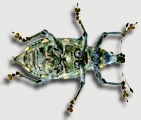Abstract:
The family Curculionidae (Coleoptera), the “true” weevils, have diversified tightly linked to the evolution of flowering plants. Here, we aim to assess diversification at a lower taxonomic level. We analyze the evolution of the genus Trichobaris in association with their host plants.
Trichobaris comprises eight to thirteen species; their larvae feed inside the fruits of
Datura spp. or inside the stem of wild and cultivated species of Solanaceae, such as potato, tobacco and tomato. We ask the following questions: (1) does the rostrum of
Trichobaris species evolve according to the plant tissue used to oviposit, i.e., shorter rostrum to dig in stems and longer to dig in fruits? and (2) does
Trichobaris diversify mainly in relation to the use of
Datura species? For the first question, we estimated the phylogeny of
Trichobaris based on four gene sequences (nuclear 18S and 28S rRNA genes and mitochondrial 16S rRNA and COI genes). Then, we carried out morphogeometric analyses of the
Trichobaris species using 75 landmarks. For the second question, we calibrated a COI haplotype phylogeny using a constant rate of divergence to infer the diversification time of
Trichobaris species, and we traced the host plant species on the haplotype network. We performed an ancestral state reconstruction analysis to infer recent colonization events and conserved associations with host plant species. We found that ancestral species in the
Trichobaris phylogeny use the stem of
Solanum plants for oviposition and display weak sexual dimorphism of rostrum size, whereas other, more recent species of
Trichobaris display sexual dimorphism in rostrum size and use the fruits of
Datura species, and a possible reversion to use the stem of Solanaceae was detected in one
Trichobaris species. The use of
Datura species by
Trichobaris species is widely distributed on haplotype networks and restricted to
Trichobaris species that originated ca. 5 ± 1.5 Ma. Given that the origin of
Trichobaris is estimated to be ca. 6 ± 1.5 Ma, it is likely that
Datura has played a role in its diversification.
DOI (full text)
